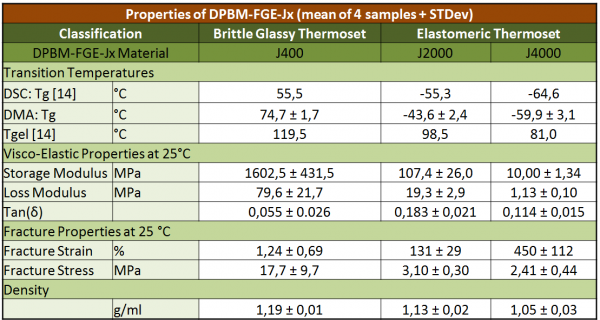Classification of DA-polymers
The three DA-materials, -J400, -J2000 and -J4000, can be classified in two groups: the ‘reversible glassy thermosets’ and the ‘reversible elastomeric thermosets’, based on their viscoelastic behavior at ambient temperature (Tambient).

To explain this classification, the glass transition temperature (Tg) has to be introduced. Tg is the temperature at which an amorphous material undergoes a reversible transition from a hard and relatively brittle glassy state into a molten or rubbery state (upon heating). On the one hand, -J400 contains furan compounds with short polymer chain length. Due to these short chains, the network has a high (reversible) crosslink density, which raises the Tg of the polymer above Tambient, leading to (brittle) glassy thermosets at Tambient. -J2000 and -J4000 on the other hand are built up out of furan compounds with longer polymer chain length, limiting the cross-link density. The latter materials are elastomeric thermosets, with ductile characteristics, and having a Tg lower then Tambient. In the table, the Tg, and the densities of the three DA-polymer materials are presented.

SPAs are constructed from hyperelastic polymers. Therefore, both elastomer DA-materials, -J2000 and -J4000, are combined in the construction of a first SH-soft pneumatic actuator (SH-SPA), exploiting the difference in mechanical properties of these two materials in the mechanical design of the SH-SPA. The brittle, -J400 material cannot be used in SPAs, however, it can be used in other robotic applications.
Recently, we used this brittle -J400 material to develop a self-healing mechanical fuse (SH-MF), which can be integrated in a series elastic actuator. This SH-MF protects the system from damaging overloads. Upon an overload on the system, potentially damaging one of the actuator components, the fuse fractures sacrificially and will be healed after removal of the overload. Using this principle all components are protected and there is no need for large over-dimensioning.
Mechanical properties of the DA-series
In order to determine the viscoelastic behavior of the self-healing polymer series at ambient temperature, Dynamic Mechanical Analysis (DMA) was carried out on the three materials. In the table the Storage modulus, Loss modulus and their ratio, the tan(delta) are presented. At 25 °C -J400 is in the glassy region (Table I), where the storage modulus (2280 MPa) is high compared to the loss modulus (111 MPa), which results in a low tan(delta), indicating that there is almost no viscous contribution. -J400 behaves like an elastic solid, almost all the energy required to deform sample is elastically recoverable. Therefore, we will consider -J400 as an elastic material (instead of viscoelastic) at ambient temperature, with a Young’s modulus equal to the storage modulus. This however is not the case for the other two materials: their viscoelastic behavior makes it impossible to neglect the viscous contribution at 25 °C and attention should be given to this in further applications. To derive the fracture stress and strain, a static stress-strain test until fracture was carried out in tension.
Mixing ability
The studied polymers differ only in spacer length, which makes it possible to mix furan compounds having a different degree of polymerization, during the synthesis of the SHmaterial. Using this mixing method a DA-polymer is obtained with a mixture of spacer lengths. In this way a polymer with desirable, intermediate material properties lying in the broad interval between the two extremes (J400 and J4000) can be obtained. This mixing ability is a great advantage since it provides a certain degree of freedom in the design of future self-healing actuator applications.
